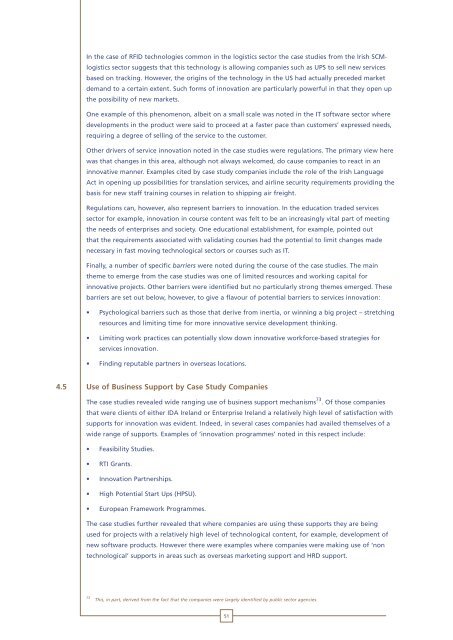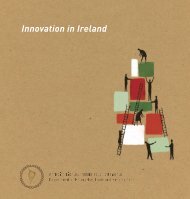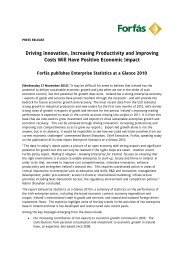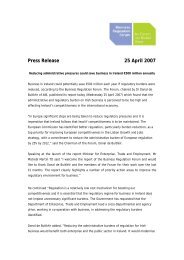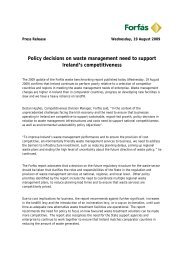Services Innovation in Ireland - Options for ... - Europe INNOVA
Services Innovation in Ireland - Options for ... - Europe INNOVA
Services Innovation in Ireland - Options for ... - Europe INNOVA
Create successful ePaper yourself
Turn your PDF publications into a flip-book with our unique Google optimized e-Paper software.
In the case of RFID technologies common <strong>in</strong> the logistics sector the case studies from the Irish SCM-<br />
logistics sector suggests that this technology is allow<strong>in</strong>g companies such as UPS to sell new services<br />
based on track<strong>in</strong>g. However, the orig<strong>in</strong>s of the technology <strong>in</strong> the US had actually preceded market<br />
demand to a certa<strong>in</strong> extent. Such <strong>for</strong>ms of <strong>in</strong>novation are particularly powerful <strong>in</strong> that they open up<br />
the possibility of new markets.<br />
One example of this phenomenon, albeit on a small scale was noted <strong>in</strong> the IT software sector where<br />
developments <strong>in</strong> the product were said to proceed at a faster pace than customers’ expressed needs,<br />
requir<strong>in</strong>g a degree of sell<strong>in</strong>g of the service to the customer.<br />
Other drivers of service <strong>in</strong>novation noted <strong>in</strong> the case studies were regulations. The primary view here<br />
was that changes <strong>in</strong> this area, although not always welcomed, do cause companies to react <strong>in</strong> an<br />
<strong>in</strong>novative manner. Examples cited by case study companies <strong>in</strong>clude the role of the Irish Language<br />
Act <strong>in</strong> open<strong>in</strong>g up possibilities <strong>for</strong> translation services, and airl<strong>in</strong>e security requirements provid<strong>in</strong>g the<br />
basis <strong>for</strong> new staff tra<strong>in</strong><strong>in</strong>g courses <strong>in</strong> relation to shipp<strong>in</strong>g air freight.<br />
Regulations can, however, also represent barriers to <strong>in</strong>novation. In the education traded services<br />
sector <strong>for</strong> example, <strong>in</strong>novation <strong>in</strong> course content was felt to be an <strong>in</strong>creas<strong>in</strong>gly vital part of meet<strong>in</strong>g<br />
the needs of enterprises and society. One educational establishment, <strong>for</strong> example, po<strong>in</strong>ted out<br />
that the requirements associated with validat<strong>in</strong>g courses had the potential to limit changes made<br />
necessary <strong>in</strong> fast mov<strong>in</strong>g technological sectors or courses such as IT.<br />
F<strong>in</strong>ally, a number of specific barriers were noted dur<strong>in</strong>g the course of the case studies. The ma<strong>in</strong><br />
theme to emerge from the case studies was one of limited resources and work<strong>in</strong>g capital <strong>for</strong><br />
<strong>in</strong>novative projects. Other barriers were identified but no particularly strong themes emerged. These<br />
barriers are set out below, however, to give a flavour of potential barriers to services <strong>in</strong>novation:<br />
• Psychological barriers such as those that derive from <strong>in</strong>ertia, or w<strong>in</strong>n<strong>in</strong>g a big project – stretch<strong>in</strong>g<br />
resources and limit<strong>in</strong>g time <strong>for</strong> more <strong>in</strong>novative service development th<strong>in</strong>k<strong>in</strong>g.<br />
• Limit<strong>in</strong>g work practices can potentially slow down <strong>in</strong>novative work<strong>for</strong>ce-based strategies <strong>for</strong><br />
services <strong>in</strong>novation.<br />
• F<strong>in</strong>d<strong>in</strong>g reputable partners <strong>in</strong> overseas locations.<br />
4.5 Use of Bus<strong>in</strong>ess Support by Case Study Companies<br />
The case studies revealed wide rang<strong>in</strong>g use of bus<strong>in</strong>ess support mechanisms 73 . Of those companies<br />
that were clients of either IDA <strong>Ireland</strong> or Enterprise <strong>Ireland</strong> a relatively high level of satisfaction with<br />
supports <strong>for</strong> <strong>in</strong>novation was evident. Indeed, <strong>in</strong> several cases companies had availed themselves of a<br />
wide range of supports. Examples of ‘<strong>in</strong>novation programmes’ noted <strong>in</strong> this respect <strong>in</strong>clude:<br />
• Feasibility Studies.<br />
• RTI Grants.<br />
• <strong>Innovation</strong> Partnerships.<br />
• High Potential Start Ups (HPSU).<br />
• <strong>Europe</strong>an Framework Programmes.<br />
The case studies further revealed that where companies are us<strong>in</strong>g these supports they are be<strong>in</strong>g<br />
used <strong>for</strong> projects with a relatively high level of technological content, <strong>for</strong> example, development of<br />
new software products. However there were examples where companies were mak<strong>in</strong>g use of ‘non<br />
technological’ supports <strong>in</strong> areas such as overseas market<strong>in</strong>g support and HRD support.<br />
73 This, <strong>in</strong> part, derived from the fact that the companies were largely identified by public sector agencies.<br />
51


